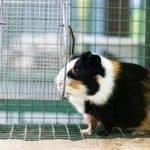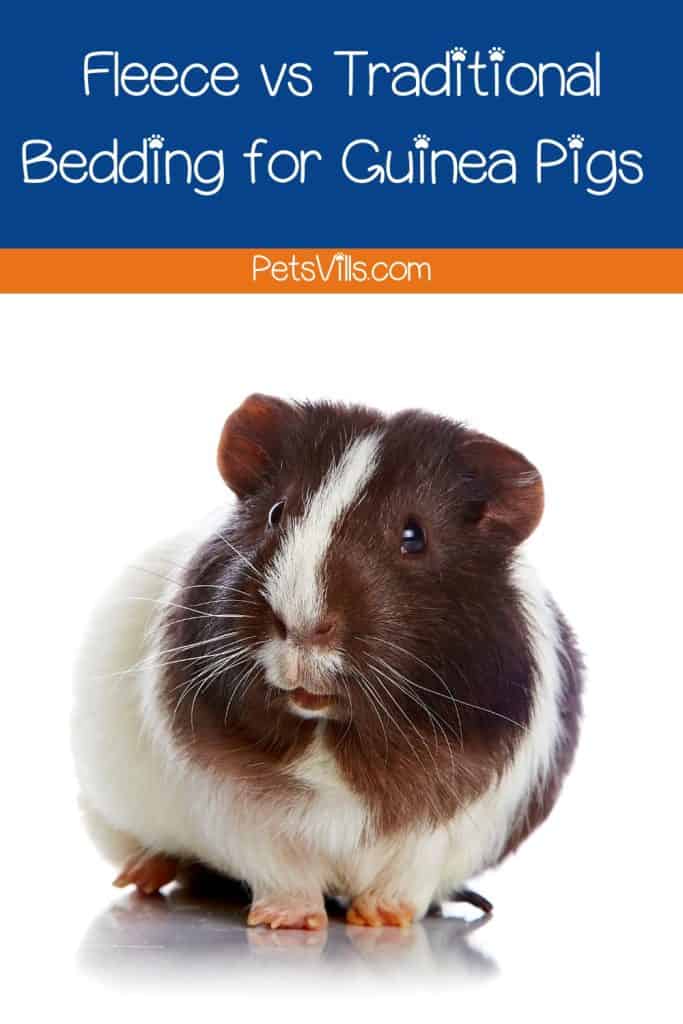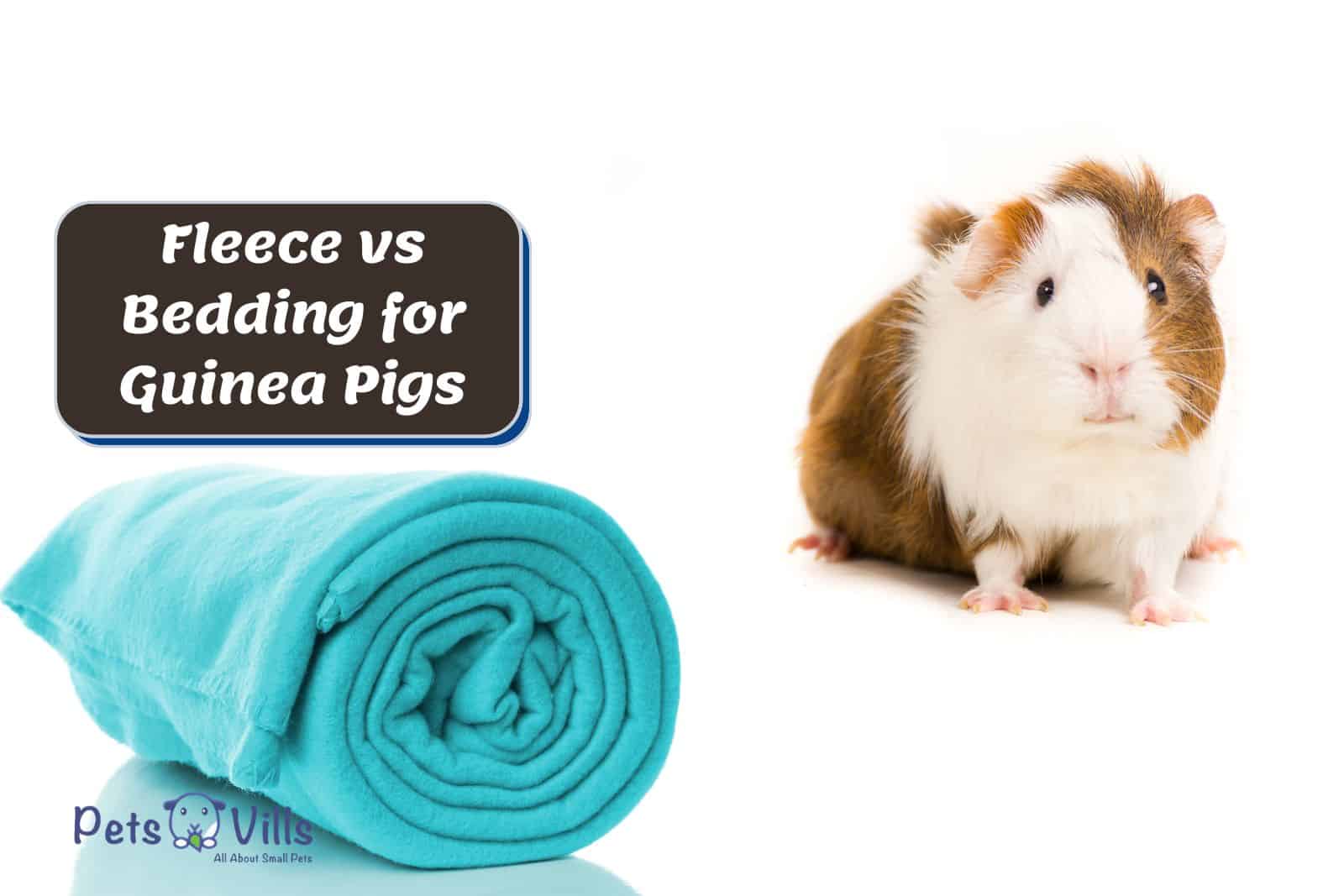Stuck in the never-ending debate of fleece vs bedding for guinea pigs? Keep reading!
As a devoted guinea pig enthusiast, I’ve conducted extensive research and trials to help you confidently choose the ideal bedding option for your guineas.
Say goodbye to uncertainty – I’ll provide you with 10 persuasive advantages to steer your decision and ensure your their happiness and well-being.
Dive into this engaging guide to resolve the debate once and for all, and create the perfect guinea haven.
Table of Contents
Key Takeaways
- Fleece bedding offers various advantages over traditional guinea pig bedding, including being more comfortable, easier to clean, and offering fewer health risks.
- But fleece has some drawbacks when compared with traditional bedding. It’s more expensive up front, doesn’t work outdoors, and requires daily cleaning.
- Generally, owners will find fleece to be a better option. However, it’ll ultimately depend on how its pros and cons match their situation.
What’s The Difference Between Fleece and Traditional Guinea Pig Bedding?
Obviously, experienced guinea pig owners won’t need an explanation of the differences. But explaining them is vital to ensure newbies aren’t confused.
I wish someone had done it for me when first choosing my cavy’s bedding. It would’ve saved me a significant amount of trouble.
So the difference between fleece and traditional bedding comes from their material. Fleece cage liners/bedding consists of fleece material, hence the name.
As for how these liners are designed, they’re multi-layer products. It’s a simple way to ensure there’s more protection and allows them to be reusable.
I’ll dive into more about the multi-layer construction in the next section.
Traditional guinea pig bedding is a much more broad term. It refers to bedding made from all the common materials like wood shavings, paper, and pine shavings.
In other words, the type of bedding is often found in significant volume at the local PetSmart or PetCo. So it’s much easier to get your hands on than fleece options.
But this hasn’t stopped fleece from becoming an increasingly popular choice. So let’s explore its advantages to see why it has become more commonplace.
10 Advantages Provided By Fleece Bedding
Several advantages come from using fleece bedding for guinea pigs. Initially, I was shocked by how many benefits it provides.
So I thought listing out my favorites could provide some insight. It’ll help you decide whether using fleece is the proper bedding for your guinea pigs.
#1 Excellent Absorption Rate
The absorption rate is a crucial part of any guinea pig cage bedding. Otherwise, these enclosures can become absolute nightmares and cause several issues.
So it stands to reason that owners should want extremely absorbent bedding. Fleece fits into this description with ease.
Honestly, I was surprised by how well it did compare to traditional guinea pig bedding options. Fleece doesn’t have a long-time rep for offering solid absorption.
But manufacturers have seemingly fixed this issue by using multi-layers. It creates a much more effective tool in ensuring moisture doesn’t build up inside your cavy’s cage.
At this point, I even give it a leg up on the traditional choices. The recent surge of these multi-layer cage fleece liners has been a revelation in this marketplace.
To ensure your furry friend has the coziest and most hygienic environment, consider choosing from our top picks for the best fleece liners for guinea pigs.
#2 Easier to Clean
One of my favorite things about fleece bedding is its easy cleaning process. It’s a much easier and less arduous process than changing out wood paper shaving bedding.
A simple spot clean will get the job done. The problem is it’s a daily task, not something you do every few days.
If you’re interested in learning how to clean and maintain your guinea pig’s fleece bedding properly, check out our comprehensive guide on How to Clean Guinea Pig Fleece Bedding.
For a quick overview, head to this video:
#3 Superior Comfort
Fleece is a superior material to what’s found in more commonplace options. It’s noticeable from the very moment an owner touches it.
Wood or paper-based bedding has no chance of competing in this area. It’s genuinely a one-horse race when it comes to the comfort level.
So anyone looking to pamper their guinea pigs should go with fleece bedding. My cavies have never been happier than when using soft fleece bedding.
Join me in this video as we embark on a cozy adventure, turning fleece into the perfect bedding for your guinea pig in just four easy steps:
#4 Gentle on Your Cavy’s Feet
Guinea pigs are known for having delicate feet. Therefore, it’s wise for owners to account for this issue when providing them with bedding.
It’s another reason why fleece is a great option. Fleece is much more gentle on a cavy’s feet than the typical wood or paper bedding.
I’d imagine it like walking on a pillow for them. It gives your cavy excellent support to ensure a better cage time experience.
Moreover, this soft surface can help prevent various foot-related diseases. A common one for these furballs is one called bumblefoot (1).
It’s an excruciating disease to contract for a guinea pig. So using fleece bedding could be another preventative measure to help keep your cavy happy!
#5 Adorable, Colorful Designs
A vastly underrated benefit to using fleece is the available color schemes. It makes designing a certain aesthetic or matching a room’s decor easier than regular bedding.
Hence, it provides owners with a significant number of options. Having more control over the decor and aesthetic of your guinea pig’s cage is nice.
I’ve also found matching the color to my cavy’s personality fun. So if they’re active and lively, I choose a brighter color to coordinate with their demeanor.
In comparison, all these possibilities are impossible with pine or wood bedding. Owners who use them are stuck with a single, dull color scheme. Who wants that?
#6 Dust-free
Dust is a massive issue with regular bedding options. It’s often what guinea pig owners complain about the most.
It hit my home like a truck when I used traditional bedding. The dust particles triggered my brother’s allergies whenever he went near my cavy’s cage.
As you can imagine, he wasn’t too happy with me. So I switched to dust-free bedding in fleece, which solved all his allergies issues with my cavy.
Cavies won’t be too fond of a dust particle build-up, either. Prolonged exposure can even cause a respiratory infection.
Respiratory infections will affect them much like it does us. It’ll lead to discharge from the eyes or nose, sneeze, or trouble breathing” (2).
It’s why pet owners would do their best to research the bedding before using one. You must ensure it limits dust production as much as possible.
Of course, switching to fleece bedding would solve all the issues immediately. But if necessary, some traditional options limit it effectively to where it’s a non-issue.
#7 Washable and Reusable Material
Cavy owners often overlook the value of fleece being washable. Unlike wood, paper, or pine savings, it makes the bedding reusable.
So why does this matter? First, it allows fleece bedding to last much longer, keeping the need for complete changes to a minimum.
Instead, I can regularly wash to keep my fleece usable. It’s a much more efficient way to maintain guinea pig bedding.
#8 Promotes Better Health
Hygiene is a vital part of keeping guinea pigs healthy and happy. Fleece helps owners with this task by helping prevent some potential health issues:
- Bacterial infections (3)
- Fungal infections
- Respiratory problems (doesn’t use problematic ingredients like added scents or oils)
Most owners don’t realize the damage these issues can cause their cavies. But high-safe beddings like high-quality fleece eliminate all these issues without sweat.
Trust me; it’s nice not to worry about this risk when caring for your cavy.
#9 Easy to Make DIY Guinea Pig Fleece Bedding
Some guinea pig owners take it upon themselves to make DIY fleece bedding. I’m not a DIY person, but it seems like a relatively simple task.
There are even several YouTube tutorials to walk you through it. Here’s a look at one of my favorites to help anyone who wants to go this route:
Making your fleece bedding using a sewing machine is also a cost-saving move. Sadly, the average fleece bedding cost is only going up in price.
#10 Cost-Effective in the Long-Term
My last notable benefit is fleece’s cost-effectiveness in the long term. Anyone using this bedding won’t have to replace it constantly like with other types.
So the initial purchase of fleece liners lasts much longer and costs less in the long run. I couldn’t believe how much money I saved over the first year of making the switch.
I’ve talked to several other owners who’ve made the same switch and had similar experiences. Fleece bedding can help you put a nice lump sum back into your savings.
5 Disadvantages Provided by Fleece Bedding
Even with all the advantages, fleece isn’t a perfect bedding choice for guinea pigs. There are some drawbacks worth noting to anyone who’s considering using it:
#1 More Expensive Upfront
The initial cost of fleece bedding is much higher than traditional bedding. As a result, it’s a hard sell, especially for a newbie owner looking to spend less than $50 on cage bedding.
In comparison, wood shavings aren’t even close to this price tag. It’s eye-opening when you first compare them.
These prices won’t be lowering anytime soon, either. It’s why many fleece bedding users go the DIY route with their trusty sewing machines.
#2 Prep is Required Before Using it
Fleece bedding isn’t an unpacked and ready-to-go type of product. Instead, there’s some preparation required to ensure it’s usable in a guinea pig’s cage.
Owners must wash the fleece beforehand in hot water several times. This process is called wicking, and it’s necessary to make the bedding effective.
In most cases, traditional bedding doesn’t have this issue. It’s why many people consider it a bit more convenient than using fleece material.
But thankfully, the wicking process doesn’t take too long. So once it’s done, please place it in your guinea pig’s cage and reap the benefits.
#3 Less Accessible
Fleece bedding is much more challenging to find in pet stores than traditional options. Most pet stores won’t even have them available.
Due to this, you’ll have to use online sites like Etsy or make your fleece. It’s a bit of a hassle, especially compared to the accessibility of other types of bedding.
#4 Requires Daily Spot Cleaning
The daily upkeep with fleece material can be a downright drag. So it’s easy to see why some people view the constant spot cleaning as a trying nuisance.
It’s especially problematic for people with multiple cavies, such as 3-6 piggies. In these cases, spot cleaning can become overwhelming and time-consuming.
#5 Not Suitable for Outdoor Use
Fleece bedding and outdoor cages are a terrible match. The conditions will only rob this material of its effectiveness and convenience.
So anyone with an outdoor hutch for guinea pigs will need to use regular bedding. I’d recommend kiln-dried pine shavings as the go-to choice.
Final Verdict: What’s The Best Option for Your Guinea Pigs?
Now that you’ve feasted on the fleece vs bedding for guinea pigs question, you’ve soon discovered the magic answer:
Generally, fleece is a better option than traditional bedding options. It’s more comfortable, easier to clean, offers better absorption, and promotes better overall health.
But some owners won’t have the means for it. For instance, the initial price could scare them off, or their guinea pig cages are located outdoors.
Both circumstances represent situations where traditional bedding would be more fitting. So it’s vital to know the ins and outs of these bedding before making a final decision.
If you do find fleece to be suitable, check my next section. I’ll walk you through some tips to help ensure you have a clean cage for your guinea pigs.
Plus, for an informative video into the world of fleece bedding, check out this video on the pros, cons, and more:
Tips for Keeping the Cage Clean and Cleaning Fleece Bedding
“Well-designed housing which is easy to maintain and caters for the comfort and well-being of the animal is essential.” writes guinea pig expert Denise Elizabeth Noonan [4].
Over time, I’ve learned a few tricks to getting the most out of using fleece bedding. So here’s a small list of tips that can help keep your entire cage clean and well-maintained:
- Place small pads around your fleece bedding liners for guinea pigs. Set them in areas where moisture acclimates: bathroom areas, hay racks, water bottles, etc.
- Fleece liners and their absorbent layers must be removed when cleaning cages. Shake off the poop/hay and put them in your washing machine.
- Please wash them in hot, unscented water without laundry detergent. If not, it could cause health issues for your cavies.
- Put them in the clothes dryer on a low setting without dryer sheets. It’s the only to ensure nothing affects the fleece’s performance long-term.
FAQs
#1 How often do you change fleece bedding on guinea pigs?

Piggy parents will want to do daily spot cleaning and change it out every 3-4 days. It might be more or less, depending on how many pigs are inside the cage.
#2 Do guinea pigs prefer fleece or paper bedding?
They prefer fleece because it offers a softer, more comfortable experience over guinea pig paper bedding. It’s also much gentler on their sensitive feet.
Conclusion
The debate of fleece vs bedding for guinea pigs is a complex one. Making the right decision will require considering the pros/cons and matching them to your personal preference.
Once you do, it’ll become clear whether fleece or regular bedding is more fitting. Remember to let me know what you choose in our comment section. Thanks for reading!

Resources
1. Pododermatitis (Bumblefoot) [Internet]. dora.missouri.edu. 2022 [cited 2023 Apr 3]. Available from: https://dora.missouri.edu/guinea-pig/pododermatitis-bumblefoot/
2. Hess L. Health Problems in Guinea Pigs [Internet]. vca_corporate. 2009. Available from: https://vcahospitals.com/know-your-pet/guinea-pigs-problems
3. Roberts-Steel S, Oxley JA, Carroll A, Wills AP. Frequency of Owner-Reported Bacterial Infections in Pet Guinea Pigs. Animals. 2019;9:649.
4. Noonan DE. (PDF) The Guinea Pig (Cavia porcellus) [Internet]. ResearchGate. 1994. Available from: https://www.researchgate.net/publication/235936317_The_Guinea_Pig_Cavia_porcellus

Andreea is a very passionate content creator and her purpose is to provide you with the most interesting articles, while constantly discovering new facts. She’s been freelance writing for the past five years and has created numerous articles and educational materials while managing her own mom blog.
Read her Latest Articles
Find her on
FACEBOOK AND Instagram


